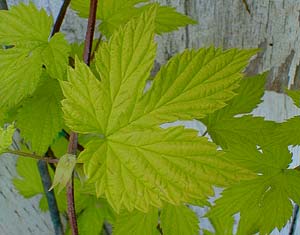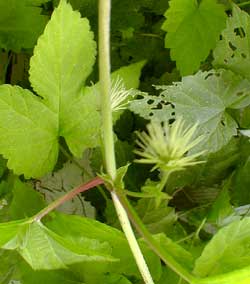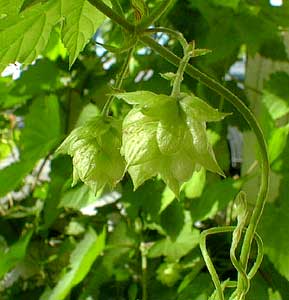
Golden Hop Vine
"I feel the breath of the summer night,
Aromatic fire:
The trees, the vines, the flowers are astir
With tender desire."
-Elizabeth Stoddard
(1823-1902)
(1823-1902)
Golden Hop Vine (Humulus lupulus 'Aureus') has bright yellow-green lobed leaves that render it the most desirable ornamental hop. It wants partial shade to full sun & moist organically rich soil, & is otherwise very low-maintenance.
Native to temperate zones from western Europe to Asia, it is cold hardy at minus 20 to 10 degrees F., dying back to dormant roots in winter, plus it is heat-tolerant in summer. The further north it is grown, the more sun it requires, but in general it needs some protection from too long a sunny day, especially 'Aureus' whose pale leaves can bleach if oversunned.
It dies completely back in winter, so whatever remains of its vines should be trimmed away. Once established it returns each spring with extreme rapidity, climbing fifteen or twenty feet in no time. The Golden variety is restrained compared to the species, but still has swift growth.
As it is dioecious (having its male & female flowers on completely separate plants), it is a consideration whether or not to find a companion vine. Mostly only the female plants are sold in garden centers. Hops will still develop on female vines, without requiring the tiny white to yellow-green pollinating male flowers nearby. These hops will be of a lighter weight, because there will be no seeds inside them. In some places in Europe, the male hop is actually illegal to plant, because the unpollinated female produces more of the alpha acid that is most sought as the bitter ingredient for beer.
 Small spines on the stems are not overly stickery, but can be a consideration when deciding where this large vine is appropriately planted. Prolonged contact with the plant can cause skin irritation. The roots sucker & spread, which is another consideration in its placement. Ours is against the garage, climbing out from an opening in pavers, so with luck it will remain restricted in its spread.
Small spines on the stems are not overly stickery, but can be a consideration when deciding where this large vine is appropriately planted. Prolonged contact with the plant can cause skin irritation. The roots sucker & spread, which is another consideration in its placement. Ours is against the garage, climbing out from an opening in pavers, so with luck it will remain restricted in its spread.Our hop vines are in full flower July through all of September, as shown in the third photo snapped in August. The blooms look starry little fireworks explosions, but are small & greenish white, so not awfully showy, merely gorgeous when you look closely.
The female flowers are impressive chartreuse cone-like "strobials" which look a bit like tiny one-inch artichokes. They begin to appear typically in July & August; by September they ripen into harvestable pine-scented hops. They can be used in herbal remedies or home-made beers, or merely left on the vines for their decorative charm. The third photo, snapped the very last day of August, shows some of the ripened strobials.
Hops were used from medieval times to the present to treat headaches & insomnia & a wealth of other ailments. Hops have for centuries been regarded as an intoxicating hypnogen with a calming effect on the user. It was already grown in the United States by the early 1600s, & the Delawares, Cherokee, Moegans, & Fox tribes soon discovered that brewed as a tea, it settled nerves.
Not all the effects were necessarily positive. The term "hopping mad," which had already found its way into English literature by the 1660s, was probably first spoken in hop-cultivating centers like Kent, blaming hops for the drunken rages of "hoppers" who were the itinerant laborers who worked seasonally in the hop fields.
 Hoppers were regarded as the lowest dregs of society, not only unsightly because of their poverty & lack of hygiene, but also for their arms, legs, & faces frequently being scarred by infected purple eruptions. Severe contact-dermatitis known as "hop-picker's disease" was caused by continuous exposure to the abrasive vines & the volatile oils of the strobials. To be "hopped up on drugs" or to be a "hophead" was very likely adapted from an older slang when applied to opium & heroin addicts, the poppy pod & its opiating effects being likened to hops, which are frequently alleged to be closely related to marijuana, though that notion is mere folklore.
Hoppers were regarded as the lowest dregs of society, not only unsightly because of their poverty & lack of hygiene, but also for their arms, legs, & faces frequently being scarred by infected purple eruptions. Severe contact-dermatitis known as "hop-picker's disease" was caused by continuous exposure to the abrasive vines & the volatile oils of the strobials. To be "hopped up on drugs" or to be a "hophead" was very likely adapted from an older slang when applied to opium & heroin addicts, the poppy pod & its opiating effects being likened to hops, which are frequently alleged to be closely related to marijuana, though that notion is mere folklore.Hops were once widely believed to be a cause melancholia & suicide. Superstitious moderns have reversed this old belief, so that in aromatherapy, the mere odor of hops is used as a treatment for depression. Even Abraham Lincoln had a little "hop pillow" to sleep against, the odor purportedly calming nerves & easing emotional gloom. The diametrically opposed beliefs that it causes suicidal depressions, or it calms the nerves, are not entirely disharmonious. If hops really can act as a downer, this could well induce calmness in some personalities, but inertia & misery in others.
Dr. Catherine Fenselau searched for psychotropic compounds in hops. Her 1976 data indicated there were none. But a 1983 study by R. Wohlfart et al did find a specific chemical sedative (2 Methyl-3 Buten-2-ol) that could to some degree justify the medieval & modern belief in hops as a hypnogen. It at least has a completely legitimate value for treating insomnia, although in this regard it must be noted that the three extant double-blind studies that proved this benefit did not study hops per se, but studied the effects of a blend of hops & chamomile, or of hops, valerian, & chamomile, the efficacy of which equalled that of prescription drugs, but without risk of side-effects.
Because hops are alleged to have a mild intoxicating & hypnotic effect, & is legitimately at least a calmative, it is sometimes used as a beer-substitute to wean alcoholics from actual beer, & has even been recommended by herbal quacks as a treatment for delirium tremons. It should be noted that delirium tremons is a life-threatening condition & treatment by superstitious methods is scarsely to be recommended. Nevertheless, since hops are in fact widely associated with beer, we might hypothesize it does have a stronger than average placebo effect if used in the context of alcohol substitution.
Many of the beliefs about hops derive from their effect when fermented in beer, & has no more to do with the hops per se than drunkenness on vodka is caused by baked potatoes. Yet the bitter hop oil & resins known as lupulin (such as function as a preservative & provide the bittering in beers) does have antimicrobial properties that have been well studied & are certain. It has also been shown to be a credible treatment for gastritis.
Almost every herbal remedy will at one time or another be pitched by herbal con-artists as a cure for cancer, & hops is no exception. But suprisingly enough, a University of Oregon study found that xanthohumol, extracted from hop flavanoids, inhibited an enzyme called "cytochrome P450" such as is implicated in some cancers. The statistical effect of the extract doesn't make pills made from ground up whole hops a credible cancer treatment as herbal quacks falsely promise, but it's nice to report any degree of legitimacy.
Another persisting superstition about hops also survived scientific scrutiny. Reports of menstrual disturbance in women who worked in hop fields, & impotence in men who drink beer, lent to the widespread belief that hops have an estrogenic property that lowers men's libido & causes breast enlargement in women. A 1973 analysis headed up by Catherine C. Fenselau, professor (& now Dean) of chemistry & biochemistry at the University of Maryland, could find no basis for belief in these responses, because plant phytoestrogens do not generally cross over to human responses.
But a 1999 study at the School of Biomedical Sciences of King's College, London, headed by S. R. Milligan, did find an unusually potent plant phytoestrogen in hops, namely 8-prenylnaringenin. This is sufficient to lend scientific credence to the belief that men who drink beer are prone to impotency, or women laboring in hop fields will have disruptions in their menstrual cycle. Alas for women who have paid money for "breast enlargement pills" made of hop powder, this is just another scam of the "herbal dietary supplements" industry which pretends to be medically driven if you're a customer, but are suddenly only food supplements when proofs of efficacy are required by the FDA.
Hops were already garden plants in Pliny's day, when ancient Romans grew them for their attractiveness, & to eat the young shoots in spring salads. Pliny is also the source of its species name lupulus because, he reported, the vine strangled & killed willows as wolves (lupus) killed sheep. The common name "hops" is itself very old, from the Anglo-Saxon hoppen, to climb.
The inspiration for genus name Humulus is uncertain & lost in time, though often said to be derived from humus ("soil") because it likes to grow in soil. Many have commented on what a silly explanation that is, since there's nothing about hop vines that suggest they more than other plants like to grow in soil. But since humulus & humus do share the same root origin in language, the magical or medicinal properties of hops could well have associated it from greatest antiquity with things cthonic (humus) associated with Man (homonid), since humanity itself was made from the earth. The hop vine was after all regarded as an "intoxicating vine" no less than were grapes for wine.
The Sumerian goddess Geshtinanna had rule of autumn vines. Her brother was Dumuzi. After Inanna brought him back out of the earth & restored him to life, he lay with Inanna, so that she gave birth to herbs, & afterward Dumuzi died back into the earth to dwell as the consort of Ereskigal, queen of the cthonic realm. Echoes of this myth track through all of recorded history, always with associations with vines & with strangling serpents, particularly in women's maenadic cults of Cybele & Dionysios. The meanads would wrap themselves in vines & serpents & imbibe all manner of mind-altering plants & brews before raging like wolves across the countryside, & raging goddesses & demonesses as varied as Artemis, Aphrodite, & even Lilith bore the epithet "wolfish" in ancient literature, prayers, & magical incantations.
So when Pliny said the hop vine strangled willows as wolves devour sheep, he was not over-reaching for a simile as first appears. The average Roman would already know the wolfish qualities of bacchantes & of Cybele, who was Magna Mater, the Great Mother of the Coleseum, to whom wolves & vines & serpents were sacred. Because the wolf was the symbol of all Rome, it was not invoked only for idle similes.
So in all, I believe it has been an error to search for separate origins for the ancient names Humulus & lupulus, as it is one word indicating the Cthonic Wolf Vine, a source simultaneously of healing & of melancholic madness, just as Cybele was the source of all life & happiness, & of all death & sorrow, as well as sober wisdom & intoxicated madness.